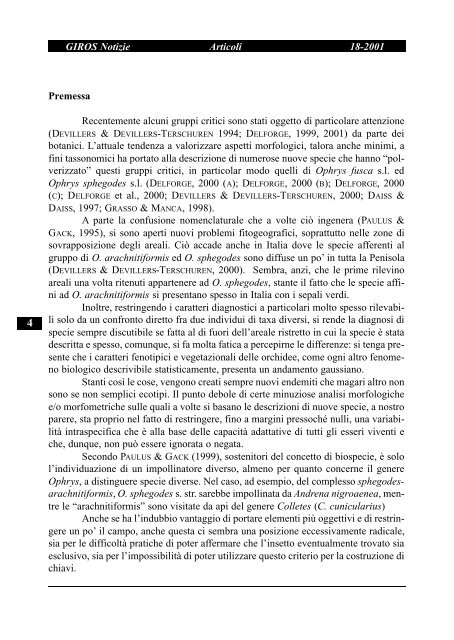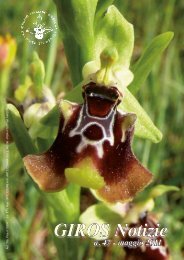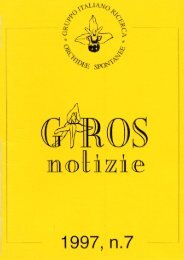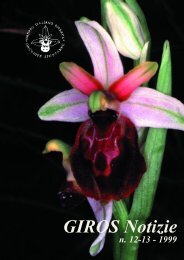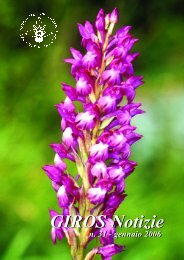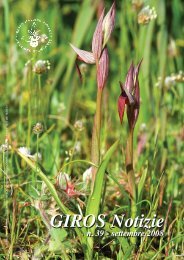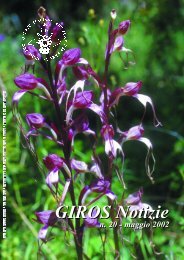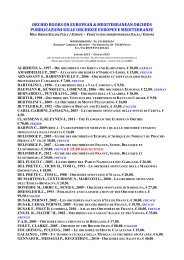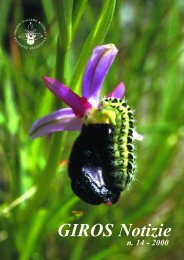Ophrys mirabilis Geniez & Melki, nuova stazione in provincia di ...
Ophrys mirabilis Geniez & Melki, nuova stazione in provincia di ...
Ophrys mirabilis Geniez & Melki, nuova stazione in provincia di ...
Create successful ePaper yourself
Turn your PDF publications into a flip-book with our unique Google optimized e-Paper software.
4<br />
GIROS Notizie Articoli 18-2001<br />
Premessa<br />
Recentemente alcuni gruppi critici sono stati oggetto <strong>di</strong> particolare attenzione<br />
(DEVILLERS & DEVILLERS-TERSCHUREN 1994; DELFORGE, 1999, 2001) da parte dei<br />
botanici. L’attuale tendenza a valorizzare aspetti morfologici, talora anche m<strong>in</strong>imi, a<br />
f<strong>in</strong>i tassonomici ha portato alla descrizione <strong>di</strong> numerose nuove specie che hanno “polverizzato”<br />
questi gruppi critici, <strong>in</strong> particolar modo quelli <strong>di</strong> <strong>Ophrys</strong> fusca s.l. ed<br />
<strong>Ophrys</strong> sphegodes s.l. (DELFORGE, 2000 (A); DELFORGE, 2000 (B); DELFORGE, 2000<br />
(C); DELFORGE et al., 2000; DEVILLERS & DEVILLERS-TERSCHUREN, 2000; DAISS &<br />
DAISS, 1997; GRASSO & MANCA, 1998).<br />
A parte la confusione nomenclaturale che a volte ciò <strong>in</strong>genera (PAULUS &<br />
GACK, 1995), si sono aperti nuovi problemi fitogeografici, soprattutto nelle zone <strong>di</strong><br />
sovrapposizione degli areali. Ciò accade anche <strong>in</strong> Italia dove le specie afferenti al<br />
gruppo <strong>di</strong> O. arachnitiformis ed O. sphegodes sono <strong>di</strong>ffuse un po’ <strong>in</strong> tutta la Penisola<br />
(DEVILLERS & DEVILLERS-TERSCHUREN, 2000). Sembra, anzi, che le prime rilev<strong>in</strong>o<br />
areali una volta ritenuti appartenere ad O. sphegodes, stante il fatto che le specie aff<strong>in</strong>i<br />
ad O. arachnitiformis si presentano spesso <strong>in</strong> Italia con i sepali ver<strong>di</strong>.<br />
Inoltre, restr<strong>in</strong>gendo i caratteri <strong>di</strong>agnostici a particolari molto spesso rilevabili<br />
solo da un confronto <strong>di</strong>retto fra due <strong>in</strong><strong>di</strong>vidui <strong>di</strong> taxa <strong>di</strong>versi, si rende la <strong>di</strong>agnosi <strong>di</strong><br />
specie sempre <strong>di</strong>scutibile se fatta al <strong>di</strong> fuori dell’areale ristretto <strong>in</strong> cui la specie è stata<br />
descritta e spesso, comunque, si fa molta fatica a percepirne le <strong>di</strong>fferenze: si tenga presente<br />
che i caratteri fenotipici e vegetazionali delle orchidee, come ogni altro fenomeno<br />
biologico descrivibile statisticamente, presenta un andamento gaussiano.<br />
Stanti così le cose, vengono creati sempre nuovi endemiti che magari altro non<br />
sono se non semplici ecotipi. Il punto debole <strong>di</strong> certe m<strong>in</strong>uziose analisi morfologiche<br />
e/o morfometriche sulle quali a volte si basano le descrizioni <strong>di</strong> nuove specie, a nostro<br />
parere, sta proprio nel fatto <strong>di</strong> restr<strong>in</strong>gere, f<strong>in</strong>o a marg<strong>in</strong>i pressoché nulli, una variabilità<br />
<strong>in</strong>traspecifica che è alla base delle capacità adattative <strong>di</strong> tutti gli esseri viventi e<br />
che, dunque, non può essere ignorata o negata.<br />
Secondo PAULUS & GACK (1999), sostenitori del concetto <strong>di</strong> biospecie, è solo<br />
l’<strong>in</strong><strong>di</strong>viduazione <strong>di</strong> un impoll<strong>in</strong>atore <strong>di</strong>verso, almeno per quanto concerne il genere<br />
<strong>Ophrys</strong>, a <strong>di</strong>st<strong>in</strong>guere specie <strong>di</strong>verse. Nel caso, ad esempio, del complesso sphegodesarachnitiformis,<br />
O. sphegodes s. str. sarebbe impoll<strong>in</strong>ata da Andrena nigroaenea, mentre<br />
le “arachnitiformis” sono visitate da api del genere Colletes (C. cunicularius)<br />
Anche se ha l’<strong>in</strong>dubbio vantaggio <strong>di</strong> portare elementi più oggettivi e <strong>di</strong> restr<strong>in</strong>gere<br />
un po’ il campo, anche questa ci sembra una posizione eccessivamente ra<strong>di</strong>cale,<br />
sia per le <strong>di</strong>fficoltà pratiche <strong>di</strong> poter affermare che l’<strong>in</strong>setto eventualmente trovato sia<br />
esclusivo, sia per l’impossibilità <strong>di</strong> poter utilizzare questo criterio per la costruzione <strong>di</strong><br />
chiavi.


